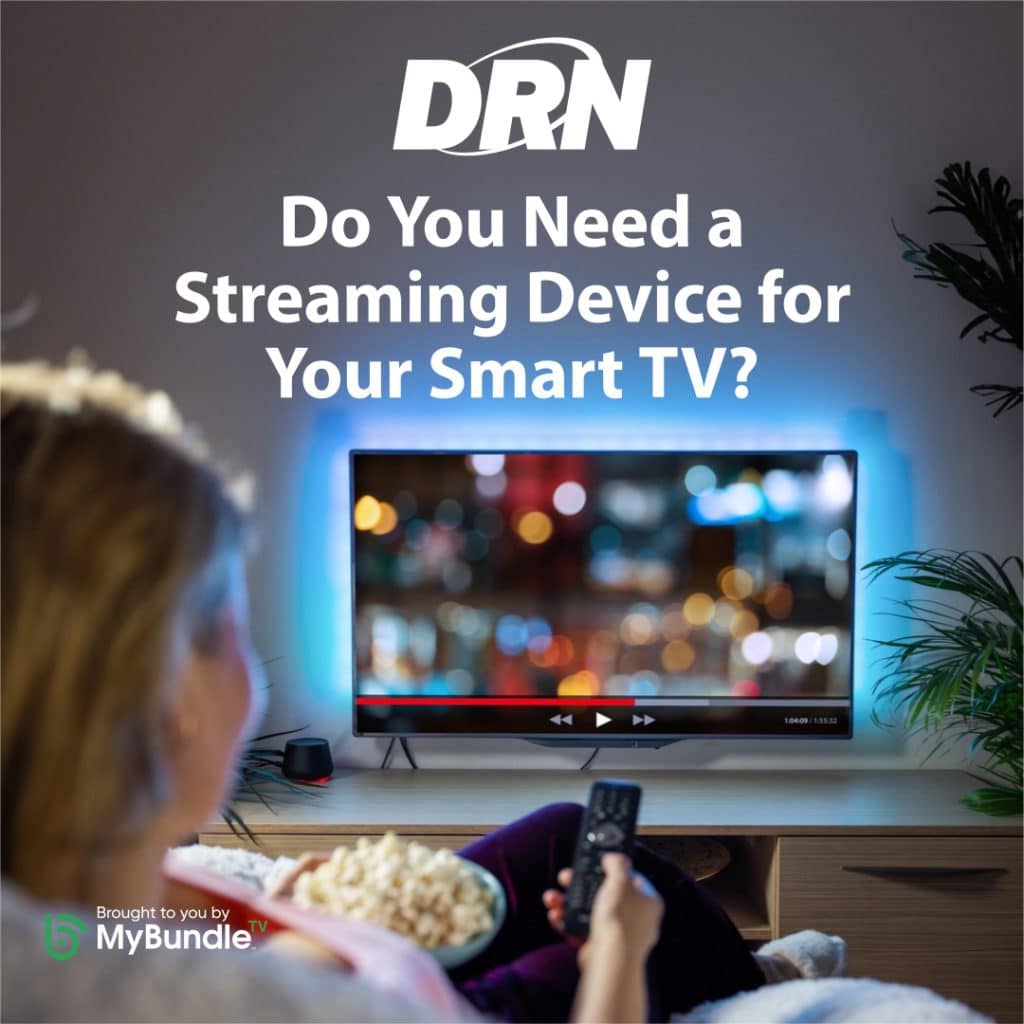I have a Smart TV. Do I need a Streaming Device?

Chances are good that you have at least one smart TV in your household that you can use for streaming entertainment like TV and movies, gaming, music, and more.
But you may have considered using a streaming device with your smart TV, especially if you’ve admired your friends’ savvy-looking setups and streaming interfaces.
Below, we discuss smart TVs and streaming devices that you can use with DRN ReadiTech’s advanced high-speed fiber internet.
With the right streaming devices, proper Wi-Fi setup, and MyBundle’s innovative and cost-saving streaming Marketplace, you will be well on your way to a superior streaming experience!
The Streaming Capabilities of Smart TVs
At its most basic, a smart TV enables viewers to stream movies and TV solely by accessing the home’s internet (i.e., without a separate streaming device plugged into it).
Indeed, by setting up the smart TV and connecting it to the home’s Wi-Fi network, most people can stream away without any other devices, wires, or equipment.
Smart TVs have their own streaming infrastructure and software, including preloaded apps and channels (usually the most popular apps like Netflix, Hulu, Peacock, and similar channels).
So, viewers need only turn on their smart TV, configure it to their internet, and navigate its streaming interface (and the apps and content they want) to begin watching at will.
For many consumers, smart TVs are ideal devices to provide just the right amount of technology to enjoy the entertainment they’re looking for.
However, while some customers are thrilled with the picture quality and generous screen sizes of the most popular smart TV models today, many other consumers are less-than-keen on their smart TVs’ streaming performance and options alone.
Common Complaints About Smart TV Streaming Limitations and Issues
One of the top complaints among smart TV owners is that the proprietary software most smart TVs include in their models is too tightly intertwined in the brand’s technological “ecosystem” to give the flexibility and customization other streaming devices provide.
Additionally, most smart TVs come with only a limited number of streaming apps and channels, leaving many viewers disappointed that their favorite app is not immediately available.
Further, many streamers lament the difficulty—or sometimes even impossibility—of adding other apps to their smart TV streaming dashboard, another frequent source of frustration.
And updating apps on smart TVs is notoriously cumbersome (or even not possible), including for security and other essential upgrades. These seemingly minor annoyances add up for consumers looking for seamless, efficient streaming.
Adding a Streaming Device May Improve Your Streaming Experience
Given the common nuisances associated with smart TVs’ streaming capabilities, it’s no wonder many customers consider adding a streaming device to their smart TV set-up.
Though it may seem unnecessary to many prudent consumers, adding a streaming device may be worth the added expense.
Now, you may be asking what a streaming device actually is, especially given the variety of tech and other gadgets out there.
Essentially, a streaming device is an electronic accessory capable of receiving and transmitting internet signals through a television’s HDMI port. This allows access to all the streaming content offered by thousands of available streaming apps and channels.
Rather than relying on the streaming capabilities of the smart TV itself, your system would stream TV and movies through the streaming device you connect to the television.
Streaming devices are usually pre-loaded with numerous apps and channels—some exceeding 10,000 or even 25,000 apps and channels of all content. They also easily permit users to download and utilize other apps, too.
Apps are usually much easier to update on streaming devices than through a smart TV’s streaming dashboard, making them more reliable and less buggy.
Streaming Sticks and Boxes to Consider
There are two main streaming device types: sticks and boxes.
Streaming sticks are finger-sized devices that are inserted into the back (or side) of any television with an HDMI port. They take up almost no space, and most do not require a flat surface like a shelf for their placement.
Popular streaming stick models include Amazon’s Fire TV Stick, Google’s Chromestick, and the Roku Premiere 4K. Each streaming stick provides an interface that users can easily organize and navigate. They also regularly update their software, keeping your system secure and “bugs” minimized.
Streaming boxes are your other option. Keep in mind that they are larger than streaming sticks—though still just a fraction of the size of bulky cable boxes! Some customers prefer streaming boxes to streaming sticks due to their generally faster processing power and speeds and extra features offered by some models.
Among the most popular streaming boxes is the Apple TV 4K, renowned for its fast operating speeds and seamless syncing within the broader Apple ecosystem.
However, Apple TV is also one of the costlier options you can pick. By far, the cheapest streaming box is the Google TV 4K Streaming Box, which costs around $20. While not the savviest choice, it still packs a punch, serves plenty of pre-loaded apps, and will suit many users’ needs—especially for a secondary or tertiary streaming TV set up in the home.
By utilizing a streaming stick or box with your smart TV, you are optimizing the power of at-home streaming technology that’s made possible with high-speed internet like DRN ReadiTech’s cutting-edge fiber network.
When combined with MyBundle, which helps you efficiently organize and manage your streaming apps and channels and lets you create watchlists in one spot across all your subscriptions, your streaming set-up will be the envy of the neighborhood!
To learn more about MyBundle and how it can enhance streaming entertainment for your family, click here. And for more streaming tech tips, check out DRN ReadiTech’s social pages!